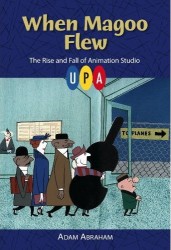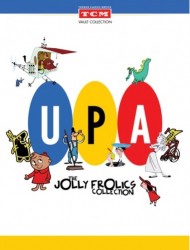Books &Hubley &UPA 07 Apr 2012 07:20 am
When Magoo Flew & Jolly Frolics
 – Adam Abraham‘s new book, When Magoo Flew: the Rise and Fall of Animation Studio UPA, is a gem. It’s an intensely researched and informed book about a studio that has gotten little real attention before this. There have been bits and pieces about specific films and people at the studio, and there’s the extraordinary chapter in Mike Barrier’s Hollywood Cartoons which encapsulates much of the material in this book.
– Adam Abraham‘s new book, When Magoo Flew: the Rise and Fall of Animation Studio UPA, is a gem. It’s an intensely researched and informed book about a studio that has gotten little real attention before this. There have been bits and pieces about specific films and people at the studio, and there’s the extraordinary chapter in Mike Barrier’s Hollywood Cartoons which encapsulates much of the material in this book.
When Magoo Flew starts off in a political mode, and in some way it stays there throughout. Perhaps that’s at the heart of the UPA story. At first, we read about the Disney strike which caused many artists and renegades to leave the Disney studio and strike out for something bigger, freedom to draw in a more modern mode. The book stays with politics as we see the formation of the UPA studio; there’s so much in fighting as partners turn on each other to take control of the studio. Once they’re in the heyday of the studio it’s the politics of who’s doing what. Animosities played a large part. When John Hubley didn’t like the painting of Herb Klynn, (“I cannot stand another touch of that Klynn green!”) he brings the brilliant painter, Paul Julian, into the studio. When Jack Heiter refused to listen to Jules Engel‘s demand to change to color ofthe sky in a background, Heiter was fired. Eventually we move to the politics of the HUAC hearings and the McCarthy era anti-Communist attacks on Hollywood. Finally, it gets down to the politics of selling and reselling the studio and the archives.
It’s a compelling story.
Within this book of politics, we see every film develop and succeed or fail. From Hell Bent for Election to Ragtime Bear (and Mr. Magoo) to Gerald McBoing Boing to Rooty Toot Toot. We see the careers of John Hubley, Bobe Cannon, Pete Burness, and many others develop and grow. All the info is in there: the history of the key shorts as well as the many feature attempts amd the two completed, as well as the mini-bios of all the people. It’s one of those books where you trust the facts and are sure the author did the homework. (The only quibble I had was in his saying that Hubley had one “big” shot at a feature with Watership Down, when in fact Hubley produced and directed two features of his own within his studio, although maybe Abraham didn’t mention them because they weren’t “big”.)
This is what I consider to be an important book in my collection, and I’d encourage everyone interested in animation history to get a copy if they can. At least, get yourself to a library to read it. I’d also like to suggest that you check out Mike Barrier‘s comments about the films of UPA in his review of the DVD. He links to the chapter in his book about the history of the films.
 There’s also a companion piece – a DVD that was released by Turner Classic Movies, and it, too, is a treasure. Jolly Frolics, the UPA Collection contains beautifully reconstructed copies of many of the one-off films, the Jolly Frolics. These, for the most part, were the non-Magoo shorts. (There will be an all Magoo release this coming June.) Many were directed by Bobe Cannon, but there are plenty of othrs by Hubley, Babbitt, and Burness as well. (I ceertainly plan to use this DVD to really go into the films and comment on some of them in the future. There’s too much wealth here for me to pass by.)
There’s also a companion piece – a DVD that was released by Turner Classic Movies, and it, too, is a treasure. Jolly Frolics, the UPA Collection contains beautifully reconstructed copies of many of the one-off films, the Jolly Frolics. These, for the most part, were the non-Magoo shorts. (There will be an all Magoo release this coming June.) Many were directed by Bobe Cannon, but there are plenty of othrs by Hubley, Babbitt, and Burness as well. (I ceertainly plan to use this DVD to really go into the films and comment on some of them in the future. There’s too much wealth here for me to pass by.)
The brilliance of Rooty Toot Toot or Gerald McBoing Boing or The Tell Tale Heart stands out against many of the others which here seem even more ordinary. The Man on the Flying Trapeze or Baby Boogie or Giddyap prove that not all UPA films are gems. Like any other cartoon studio’s product, there were good, bad and, mostly, mediocre films.
However, this collection are all marvelously brought back to their original life with this release, and TCM has to be applauded for this first collection of cartoons among their releases. The extras on the DVD includes commentary tracks by Jerry Beck and Leonard Maltin. These are worthless, as far as I’m concerned. Half of their comments involve complimenting the newly found colors of the DVD copies. Neither seems to know more than the basics about UPA. After the first commentary track, they’re all the same. With this DVD, you’re buying them for the fantastic originals on display.
When I was 11 The Gerald McBoing Boing Show premiered on CBS. Anything to do with animation meant it was playing on my family’s TV set. Ohere than these cartoons, everything anmated on TV meant the old B&W WB cartoons featuring the fat Porky Pig. There were early B&W Terrytoons as well, and even some Aesop’s Follies (silent cartoons with classical music tracks added) running on ABS. Of course, there were the special Disneyland TV shows which ran not often enough for my taste.) But the UPA cartoons were different. They looked different, they moved differently, and they struck my young eyes as important. I became an instant fan. I’ve waited for this book and DVD most of my life. It was worth the wait.

on 07 Apr 2012 at 2:37 pm 1.Rudy Agresta said …
Michael, I just finished reading my copy of WHEN MAGOO FLEW and thoroughly enjoyed it. I find it a well researched account of the history of UPA – I just wish it were longer and that some of the interesting tidbits were a bit more fleshed out as I often was left wanting for more. Nonetheless, it is an important volume worthy to be included in anyone’s animation library.
As for the JOLLY FROLICS COLLECTION – simply brilliant. One of the BEST DVD collections in my library with so many levels of use – pure enjoyment, study on all levels of animated film making, etc. I do hope that in the future they do many more UPA collections focusing on all of their other film outputs – industrial/instructional, TV commercials, and the like. While I’m at it, I would like to see a compilation, fully restored, of the work from John Sutherland Productions. I would love to see RHAPSODY IN STEEL and DESTINATION EARTH in its fully restored colorful glory.
As for the UPA book/DVD collection, both made for excellent Easter gifts to myself!!
on 07 Apr 2012 at 2:41 pm 2.Lionel Freitas said …
I love the modern style of UPA. His comments were very sincere, a penalty that material so precious never get to Brazil. I look forward to for a day alguémlançar a book on Samurai Jack, this modern animation, which made ​​me search out Mary Blair and UPA. Congratulations on the blog.
on 07 Apr 2012 at 4:28 pm 3.Michael said …
Rudy, I completely agree with you. I wish there were a bit more critical commentary about some of the films. There are absolutely no comments about the artwork once we get past 1952 and Hubley has left. A little more lyricism over some of the greats and a little more criticism of some of the poor ones.
There are some great side notes, though. One, for example, where some of the artwork has turned more like poster and utilitarian design rather than art.
All in all it’s a great book & DVD combo.
on 08 Apr 2012 at 4:34 am 4.Yowp said …
I second Rudy’s hope about the Sutherland cartoons.
So much has been made about the “UPA influence,” whether it’s on Avery/Benedict, Jones/Noble, the later Paramount cartoons, or Hanna-Barbera, it would seem natural that people should seek out the UPA cartoons to see first-hand what that “influence” was to make apt comparisons.
I’m not a UPA fan, though I do like some of the output, but I’m interested in the historical aspect of the studio so I’ll be looking for a copy of the book.
on 08 Apr 2012 at 2:14 pm 5.Tom Minton said …
The only things missing from “Jolly Frolics” are the Gene Deitch UPA short “Howdy Doody and His Magic Hat,” which is at least on You Tube (http://www.youtube.com/watch?v=r67x_pvJ8mM), and UPA’s amazing work in “The Four Poster,” a 1952 Columbia feature film. Apparently there are legal issues complicating a modern day DVD release of “The Four Poster”, which is long overdue. Most people today have never seen it. Author Adam Abraham had to travel to the Library of Congress to even see the film while researching his book. Those sequences showcased the prime of UPA firing on all cylinders and, as Abraham states in “When Magoo Flew,” marked the finest work the studio did in black and white.